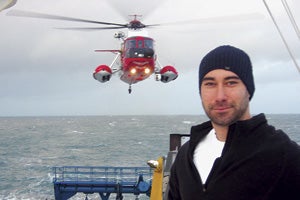Matt Horn, Ph.D. ’11
Tracking Nitrogen and CO2 in the Oceans
Matt Horn enrolled in URI’s Graduate School of Oceanography just three days after earning a bachelor’s degree from Cornell University. Three weeks later he went to sea for the first time to begin his research on how carbon dioxide (CO2) moves from the atmosphere into the ocean and back again.
 “It enters the water under high wind speed conditions, but most oceanographers only like to go to sea when it’s calm,” he said. “So I had to go to sea in the worst conditions and try to convince the ship’s captain to drive into the middle of the perfect storm.”
“It enters the water under high wind speed conditions, but most oceanographers only like to go to sea when it’s calm,” he said. “So I had to go to sea in the worst conditions and try to convince the ship’s captain to drive into the middle of the perfect storm.”
On an expedition aboard a 300-foot British research ship north of Scotland in 2007, he experienced 120-knot winds and 50-foot seas and had to be rescued by the Coast Guard.
Half way through his degree, he changed his research focus to diatoms that live at the surface of the Southern Ocean near Antarctica, one of the only places in the world where CO2 both enters and exits the ocean. He grew diatoms—single celled marine plants—in a laboratory under conditions resembling the Antarctic and analyzed the relationship between stable isotopes in their cells to the isotopic relationship found in sediment core samples from 30,000 years ago.
“CO2 levels have bounced around between 180 parts per million and 280 parts per million from one glacial cycle to another,” Horn said. “Now we’re at 390. I was looking to learn how nutrient utilization changed in the Southern Ocean and what kind of variability that has on CO2 levels over Earth’s history and see what it means for today.”
Horn now works as a chemical oceanographer at Applied Science Associates, just a few miles down the road from the GSO. He looks forward to applying his diverse background and experience to the company’s projects tracking oil and chemicals in the ocean and addressing other coastal and environmental hazards.
—Todd McLeish
 Home
Home Browse
Browse Close
Close Events
Events Maps
Maps Email
Email Brightspace
Brightspace eCampus
eCampus


